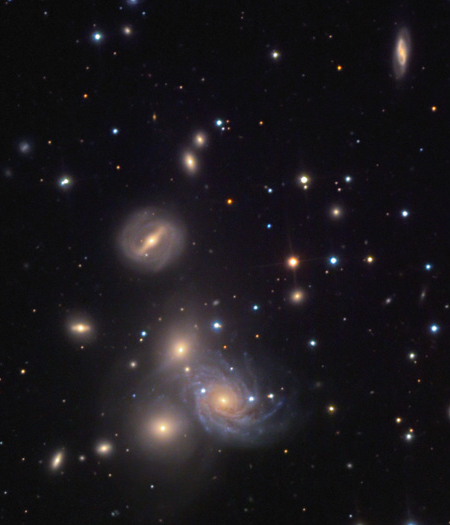Andromeda (Devyani)
Andromeda, a princess who is caught up, and hands tied around resembles the shape whenstars in Andromeda constellation are imaginarily connected, as per Indian mythology!
 Where should I see…
Where should I see…The star Alpheratz, at the face of the imaginary princess Andromeda, is also part of a constellation named Pegasus, which is towards west of Andromeda constellation. If you move your eyes towards east, you will see another constellation named Triangulum. On the North and South of Andromeda, you will find Cassiopeia and Aries constellation (first zodiac sign) respectively. Andormeda is halfway between celestial equator and North Pole, and so is fully part of Northern Hemisphere.
It covers up 722 square degree area of the sky. Area wise it is 19th largest constellation in the sky.
When and What can I see…
We can gaze at this beautiful princess shape of Andromeda constellation from mid May to February end.
All you need is your eyes other than clear skies to see 173 stars of this constellations, as they are the one which are brighter than the limit of our naked eyes (i.e. 6.5 apparent magnitude). The brightest star of Andromeda is Alfertz (Sirah). The Indian name is Uttara Bhadrapad, whichis also known as Nakshatra (lunar mansion).
Constellations are made up of single, binary (apparent and absolute), multiple and variable stars. Out of total 173 stars of different types, here is the list of 20 brightest stars as per their nature
| Binary / Multiple Star system | Variable Stars | Binary / Multiple and Variable stars | Single stars |
| Almach | 3 | Alphertz | Nembus |
| 4 | – | Mirach | 4 |
| – | – | 5 | – |
| 5 | 3 | 7 | 5 |
Mythology stories…
 In Indian mythology, it is said that when Rishis and Philosophers first saw Devyani tara mandal (Andromeda constellation) which is names as Devyani by them, actually looked like a shape of a beautiful princess whose hands were tied. Actually, there are many stories associsated with Devyani. But one of them is that, Devyani is daughter of Shankaracharyaji and Urjastavini. There are stories of Devyani’s friend and foe relation with Sharmishtha, and about the marriage of Devyani and Yayati.
In Indian mythology, it is said that when Rishis and Philosophers first saw Devyani tara mandal (Andromeda constellation) which is names as Devyani by them, actually looked like a shape of a beautiful princess whose hands were tied. Actually, there are many stories associsated with Devyani. But one of them is that, Devyani is daughter of Shankaracharyaji and Urjastavini. There are stories of Devyani’s friend and foe relation with Sharmishtha, and about the marriage of Devyani and Yayati.
Deep Sky Objects…
 Andromeda Galaxy
Andromeda Galaxy
 Andromeda’s Cluster || Mayall ii || Globular Cluster
Andromeda’s Cluster || Mayall ii || Globular Cluster
 Blue Snowball Nebula || Planetary Nebula
Blue Snowball Nebula || Planetary NebulaAll the stars that we see naked eyes, all belong to our own, Milky way galaxy (Akash Ganga Tara Vishv). Bright stars can be seen naked eye and faint one through telescope. But the curtain of sky that we see in 2D is actually a huge universe we are talking about, with 3 dimension. There are many nebulous objects visible in every constellations, they differ widely by distances and nature. Many are different types of nebulae like Emission Nebula, Reflecting Nebula, Absorption Nebula, Star Birth Nebula, Supernova Remnants (SNR) and Open Stars cluster which are within the disk of our own Milky Way galaxy. Globular cluster are also found, which are in the halo of our galaxy and some most distant objects like galaxies are also visible through telescope. Such objects are defined as “Deep Sky Objects”.
In this constellation there are 198 such different types of Deep Sky Objects observed. Out of these one is very interesting and; famous Andromeda spiral galaxy visible even through naked eye. It is the farthest naked eye object visible at 2.2 million light year distance.
Below is the list of 20 brightest Deep Sky Objects:
 NGC 90 & NGC 93 || Interacting Spiral Galaxies
NGC 90 & NGC 93 || Interacting Spiral Galaxies
 NGC 68 || Group of galaxy with a lenticular galaxy at centre
NGC 68 || Group of galaxy with a lenticular galaxy at centre
 NGC 68 || Galaxy Cluster
NGC 68 || Galaxy Cluster
| Visibility | Galaxy | Open Cluster | Globular Cluster | Nebula | Supernova Remanant |
| Naked eyes | M31 – Andromeda Galaxy | 2 | – | – | – |
| Telescope | M 110 | 1 | – | 1 | – |
| M 32 | |||||
| 13 | |||||
| 20 | 16 | 3 | 1 |
 M32 Le Gentil || Dwarf Galaxy
M32 Le Gentil || Dwarf Galaxy
 M110 || Open Cluster
M110 || Open Cluster
 NGC 206 || Brightest Star cloud
NGC 206 || Brightest Star cloud



 In Indian mythology, it is said that when Rishis and Philosophers first saw Devyani tara mandal (Andromeda constellation) which is names as Devyani by them, actually looked like a shape of a beautiful princess whose hands were tied. Actually, there are many stories associsated with Devyani. But one of them is that, Devyani is daughter of Shankaracharyaji and Urjastavini. There are stories of Devyani’s friend and foe relation with Sharmishtha, and about the marriage of Devyani and Yayati.
In Indian mythology, it is said that when Rishis and Philosophers first saw Devyani tara mandal (Andromeda constellation) which is names as Devyani by them, actually looked like a shape of a beautiful princess whose hands were tied. Actually, there are many stories associsated with Devyani. But one of them is that, Devyani is daughter of Shankaracharyaji and Urjastavini. There are stories of Devyani’s friend and foe relation with Sharmishtha, and about the marriage of Devyani and Yayati.